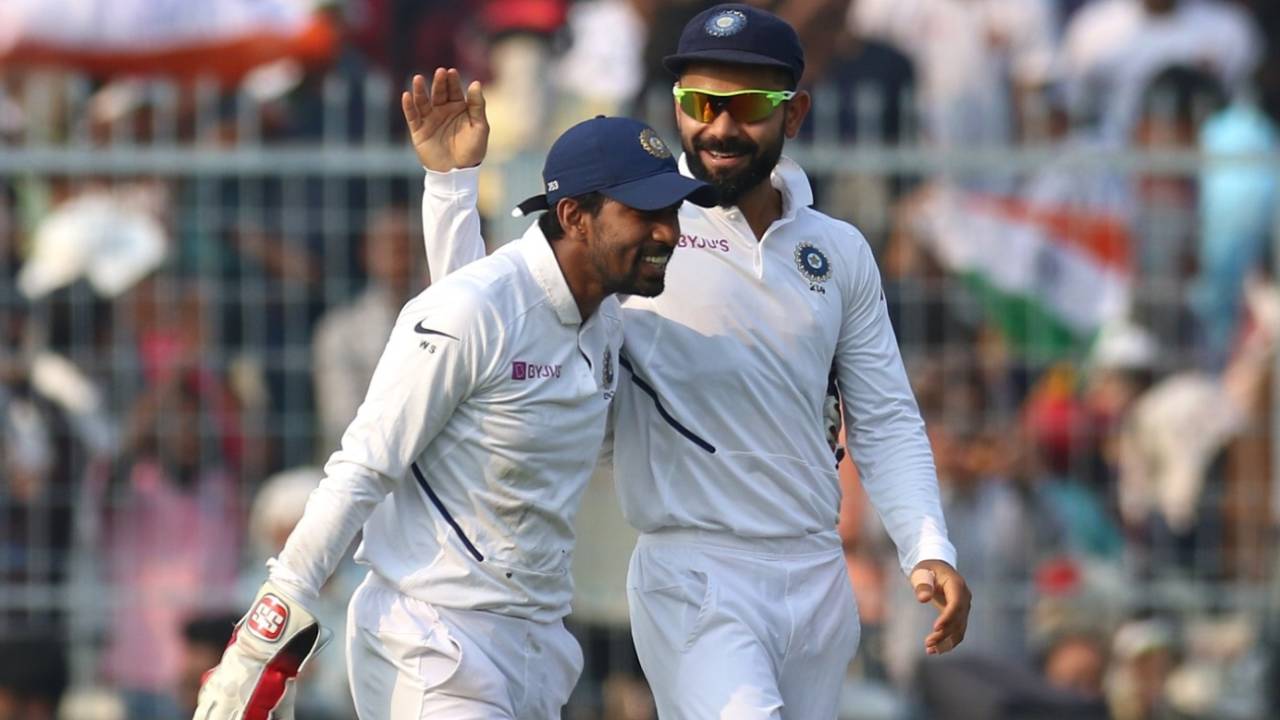The Saha masterclass on keeping against a swinging pink ball
In the first session, Saha probably had to contend with more swing than any batsman, but he aced that challenge
Varun Shetty in Kolkata
22-Nov-2019
Virat Kohli congratulates Wriddhiman Saha on his brilliant catch to dismiss Mahmudullah • BCCI
Most thoughts from players leading into the day-night Test in Kolkata were around the pink ball's visibility for batsmen, particularly during the transition from natural light to artificial lights. Only two days before the game did the conversation broach the topic of fielding and catching the pink ball. India wicketkeeper Wriddhiman Saha admitted that, for him, it was more of a wait-and-see kind of situation than one of knowing; he said that the colour of the sightscreen could probably be one the biggest factors for him and the slip cordon.
Even accounting for that, though, he wouldn't have imagined that just over an hour after noon, in a match being played in India, he would have to leap about to collect hooping balls like it was a Test in England.
In the first session of play, Saha probably had to contend with more swing than any batsman. It appeared that the ball's behaviour in the air and then off the surface was roughly the same as that of a red ball. That was until it went past the batsman. From there, the pink ball often swerved viciously in either direction, and Saha was forced to dive full length on either side to gather the ball. Barring two excessively swinging deliveries that sped to the fine-leg boundary, he got to each one.
Within the first few overs, Saha had already received multiple pats on the back from his team-mates in the slip cordon. His first big effort was when Shadman Islam left an Ishant Sharma delivery that curved towards first slip. Saha had to lunge low with his left hand out to grab it. Shortly after, he held on to one that jagged back in, brushed Imrul Kayes' thigh and kept going down leg. That was to his right. With those two, a template was set early on, and Saha constantly drew from it in a short Bangladesh innings.
Eight byes in an innings of 106 aren't great returns on the face of it, but there was little a wicketkeeper could have done about those two boundaries. It appeared that India's seamers themselves, particularly Umesh Yadav, were having difficulty being as consistent with their lines as they have been in recent times. In order to preserve the pink ball's effectiveness, there is more lacquer on it than on the red ball. During their fielding drills, India had found that this was causing the ball to travel quicker through the air and hit the hands harder. It was also seemingly making it difficult for the bowlers to control the ball.
This, by no means, is a new phenomenon in cricket. Bowlers sometimes even struggle to keep control of how the red ball moves in countries like England and New Zealand, where exaggerated movement in the air is a common sight. It is also one of the reasons teams swear by having regular wicketkeepers in this age of all-round cricketers.
Saha missed India's tour to England last year, where Rishabh Pant, overall, made a bright start to his Test career but was often found struggling to cope with the late movement behind the stumps. That, of course, was during the near-two-year period for which Saha was out injured from international cricket, and prompted several discussions on Pant's suitability as a Test wicketkeeper, and whether he should continue to be the first choice because of his runs.
That discussion was put to rest last month when Saha came straight back into the XI as India were satisfied with his fitness, and got the backing of his captain, who called him "the best wicketkeeper in the world".
In that series, Saha put on a masterclass in Pune, taking an excellent diving catch against pace early on and then displaying cat-like reflexes in keeping against spin. On Friday, he showed some of the ways he might have tackled the conditions on that England tour last year.
Most wicketkeepers don't go into a full squat against fast bowling the way they do against spin. It is perhaps a way to shed the extra load on the lower back every time they have to spring up. Pant got into deep squatting positions after taking a couple of steps during the Australia tour late last year. Much closer, in this Test, Bangladesh's stand-in wicketkeeper Mohammed Mithun was mostly upright - slight bend of the upper body, walking to a mark - before getting down just before the ball reached the batsman.
Saha is somewhere in the middle. Neither as upright as Mithun, nor as low as Pant, and decidedly more static than both. At many points on Friday, Saha and Rohit Sharma's postures were identical when a bowler ran in. Incidentally, Rohit was the one to produce the other stunning piece of catching on the day.
But in essence, Saha's stance kept him low and steady enough to be able to watch the ball closely. He has always been agile, and even after a long time out of the game and a return at the age of 34, has retained his reflexes. It all came together on Friday as he threw himself around, stopping at least three deliveries down the leg side that he would have been pardoned for missing. It has been 23 months since Saha has played in an overseas Test, but in unlikely circumstances, he got to put on a show of all that he brings to this team. It was justified that the loudest applause of India's bowling innings came at the replay of his catch to dismiss Mahmudullah.
Varun Shetty is a sub-editor at ESPNcricinfo
